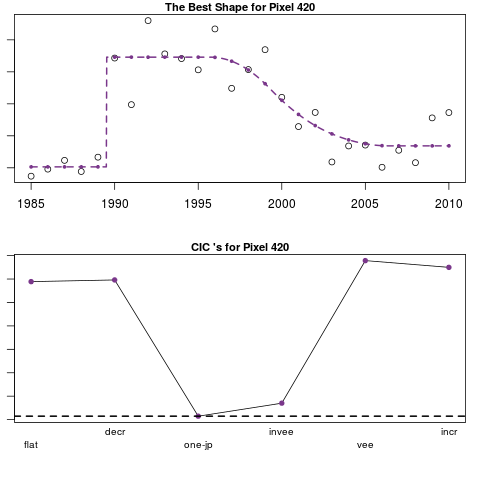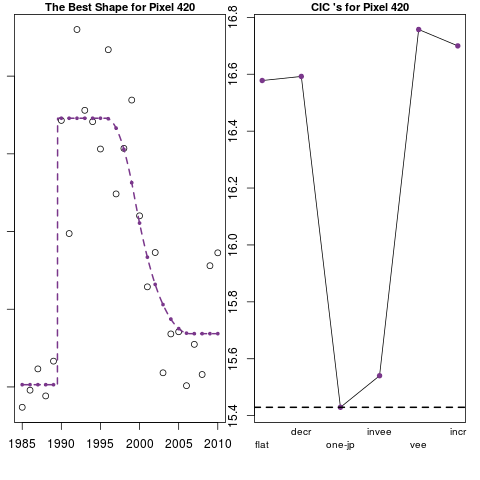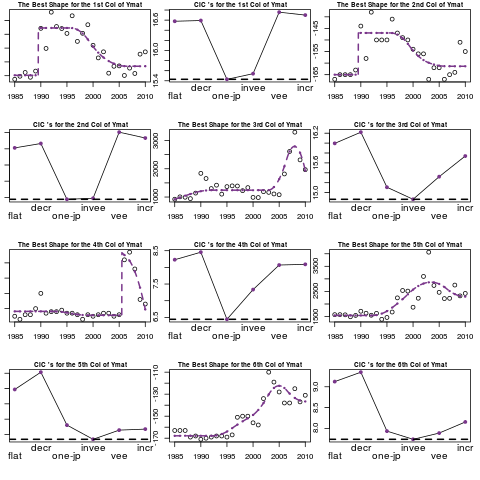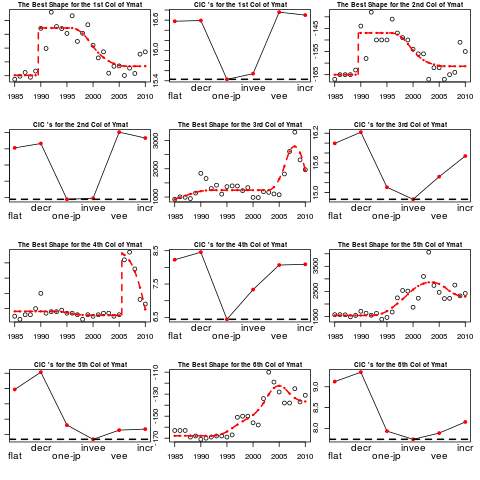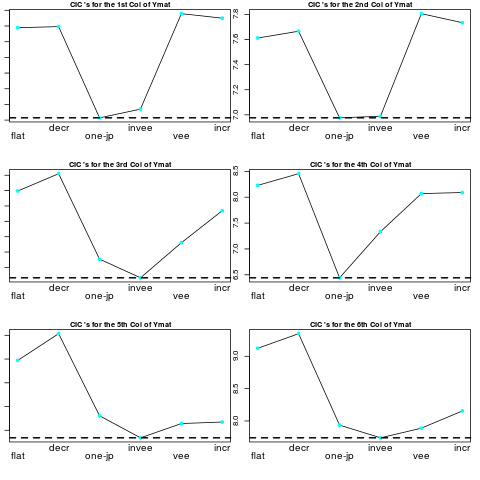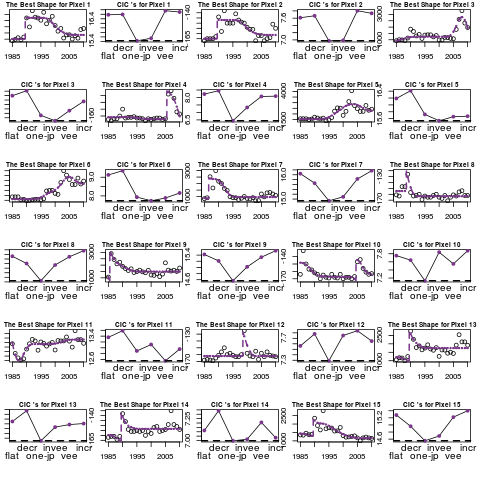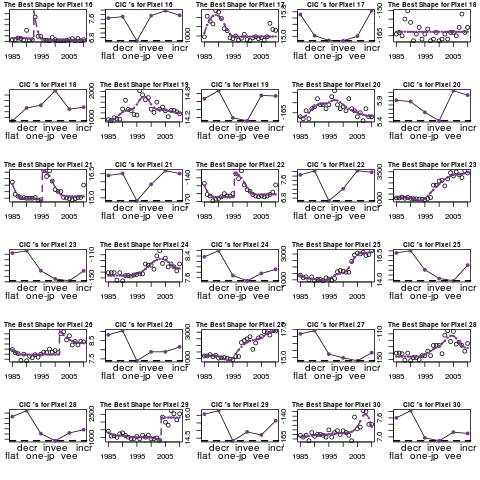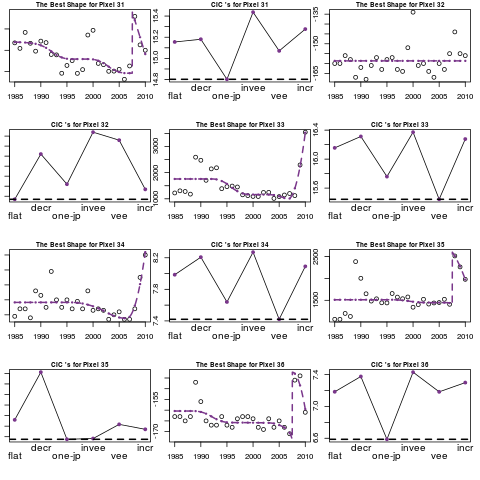Supported by Dr. Osamu Ogasawara and  providing providing  . . |
|
Last data update: 2014.03.03 |
The Plot Routine for an Object of the Shape RoutineDescriptionThis routine can plot the best shape selected by the shape routine for each scatterplot of Landsat signals. It can also plot the "BIC" or "CIC" values against shapes for each scatterplot, which is a way to verify that the best shape selected has the smallest "BIC" or "CIC" value. Usageplotshape(object, ids = 1, color = "mediumorchid4", lty = 1, lwd = 1, cex = .83, cex.main = .93, form = TRUE, icpic = FALSE, both = TRUE, tt = NULL, transpose = FALSE, plot = graphics:::plot) Arguments
ValueA plot showing the fitted trajectory of the best shape, or showing the "BIC" or "CIC" values against shapes of an object of the shape routine. Author(s)Xiyue Liao ReferencesThe official documentation for the generic R routine plot: http://stat.ethz.ch/R-manual/R-devel/library/graphics/html/plot.html. The official documentation for the generic R routine lines: http://stat.ethz.ch/R-manual/R-devel/library/graphics/html/lines.html. The official documentation for the generic R routine par: http://stat.ethz.ch/R-manual/R-devel/library/graphics/html/par.html. See Also
Examples
# import the matrix of Landsat signals
data("ymat")
# define the predictor vector: the year 1985 to the year 2010
x <- 1985:2010
# make a fit by the shape routine using "CIC"
# and not allow a double jump shape.
ans <- shape(x, ymat, "CIC", db = FALSE)
# make a plot for the 1st column of ymat
plotshape(ans, ids = 1, both = TRUE, form = TRUE, tt = "Pixel 420")
# transpose the layout
plotshape(ans, ids = 1, both = TRUE, form = TRUE, tt = "Pixel 420", transpose = TRUE)
# make a plot for each of the first 6 columns of ymat
# showing the best shape
# and "CIC" values against the 7 shapes for each plot.
par(mfrow = c(3, 2))
plotshape(ans, ids = 1:6)
# make a plot for each of the first 6 columns of ymat
# showing both the best shape
# and "CIC" values against the 7 shapes for each plot.
# Let the routine make the layout.
plotshape(ans, ids = 1:6, form = TRUE, col = 2)
# plot the ic values only
plotshape(ans, ids = 1:6, form = TRUE, col = 5, icpic = TRUE)
# make a title vector
tts <- paste('Pixel', 1:36, sep = " ")
# make all plots for the 36 scatterplots with the title vector
plotshape(ans, ids = 1:15, both = TRUE, form = TRUE, tt = tts[1:15], cex = .5)
plotshape(ans, ids = 16:30, both = TRUE, form = TRUE, tt = tts[16:30], lty = 2, cex = .3)
plotshape(ans, ids = 31:36, both = TRUE, form = TRUE, tt = tts[31:36], lty = 2, cex = .1)
Results
R version 3.3.1 (2016-06-21) -- "Bug in Your Hair"
Copyright (C) 2016 The R Foundation for Statistical Computing
Platform: x86_64-pc-linux-gnu (64-bit)
R is free software and comes with ABSOLUTELY NO WARRANTY.
You are welcome to redistribute it under certain conditions.
Type 'license()' or 'licence()' for distribution details.
R is a collaborative project with many contributors.
Type 'contributors()' for more information and
'citation()' on how to cite R or R packages in publications.
Type 'demo()' for some demos, 'help()' for on-line help, or
'help.start()' for an HTML browser interface to help.
Type 'q()' to quit R.
> library(ShapeSelectForest)
Loading required package: coneproj
Loading required package: raster
Loading required package: sp
Loading required package: rgdal
rgdal: version: 1.1-10, (SVN revision 622)
Geospatial Data Abstraction Library extensions to R successfully loaded
Loaded GDAL runtime: GDAL 1.11.3, released 2015/09/16
Path to GDAL shared files: /usr/share/gdal/1.11
Loaded PROJ.4 runtime: Rel. 4.9.2, 08 September 2015, [PJ_VERSION: 492]
Path to PROJ.4 shared files: (autodetected)
Linking to sp version: 1.2-3
> png(filename="/home/ddbj/snapshot/RGM3/R_CC/result/ShapeSelectForest/plotshape.Rd_%03d_medium.png", width=480, height=480)
> ### Name: plotshape
> ### Title: The Plot Routine for an Object of the Shape Routine
> ### Aliases: plotshape
> ### Keywords: graphic routine
>
> ### ** Examples
>
> # import the matrix of Landsat signals
> data("ymat")
>
> # define the predictor vector: the year 1985 to the year 2010
> x <- 1985:2010
>
> # make a fit by the shape routine using "CIC"
> # and not allow a double jump shape.
> ans <- shape(x, ymat, "CIC", db = FALSE)
>
> # make a plot for the 1st column of ymat
> plotshape(ans, ids = 1, both = TRUE, form = TRUE, tt = "Pixel 420")
>
> # transpose the layout
> plotshape(ans, ids = 1, both = TRUE, form = TRUE, tt = "Pixel 420", transpose = TRUE)
>
> # make a plot for each of the first 6 columns of ymat
> # showing the best shape
> # and "CIC" values against the 7 shapes for each plot.
> par(mfrow = c(3, 2))
> plotshape(ans, ids = 1:6)
>
> # make a plot for each of the first 6 columns of ymat
> # showing both the best shape
> # and "CIC" values against the 7 shapes for each plot.
> # Let the routine make the layout.
> plotshape(ans, ids = 1:6, form = TRUE, col = 2)
>
> # plot the ic values only
> plotshape(ans, ids = 1:6, form = TRUE, col = 5, icpic = TRUE)
>
> # make a title vector
> tts <- paste('Pixel', 1:36, sep = " ")
>
> # make all plots for the 36 scatterplots with the title vector
> plotshape(ans, ids = 1:15, both = TRUE, form = TRUE, tt = tts[1:15], cex = .5)
> plotshape(ans, ids = 16:30, both = TRUE, form = TRUE, tt = tts[16:30], lty = 2, cex = .3)
> plotshape(ans, ids = 31:36, both = TRUE, form = TRUE, tt = tts[31:36], lty = 2, cex = .1)
>
>
>
>
>
>
> dev.off()
null device
1
>
|
